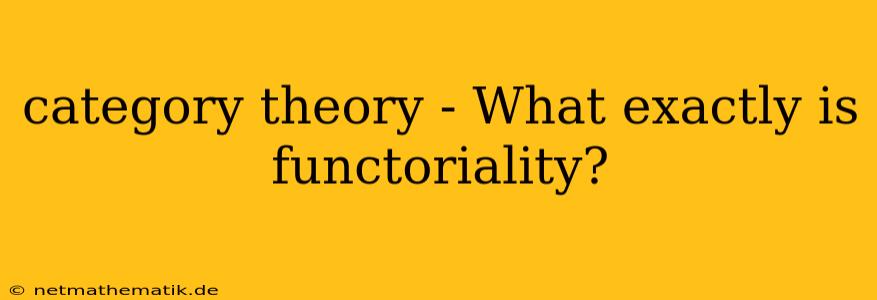Category theory, a foundational framework in mathematics, provides a powerful lens for understanding the relationships between different mathematical structures. At its core lies the concept of functoriality, a fundamental principle that governs how these structures interact. Functoriality, in essence, describes the way in which mappings between categories preserve the essential structure of the objects and morphisms within them. In this exploration, we delve into the essence of functoriality, revealing its significance in connecting diverse mathematical realms.
The Essence of Functoriality
Functoriality, at its core, is about mapping between categories while respecting the underlying structure. To grasp this concept, let's first define what a category is. A category consists of two key elements: objects and morphisms. Objects represent the mathematical structures we are interested in, such as sets, groups, or topological spaces. Morphisms, on the other hand, are the relationships between these objects, often referred to as arrows or functions. These morphisms must satisfy certain properties, such as associativity and the existence of identity morphisms.
Now, a functor is a mapping between two categories that preserves these structural relationships. It acts on both objects and morphisms, ensuring that the relationships between objects are maintained in the target category. More formally, a functor F from category C to category D, denoted as F: C → D, must satisfy the following two conditions:
- Object mapping: For every object X in category C, F assigns an object F(X) in category D.
- Morphism mapping: For every morphism f: X → Y in category C, F assigns a morphism F(f): F(X) → F(Y) in category D, such that:
- F(id<sub>X</sub>) = id<sub>F(X)</sub> (preservation of identity morphisms)
- F(g ◦ f) = F(g) ◦ F(f) (preservation of composition)
These conditions ensure that the functor F faithfully translates the structure of category C into category D. It essentially 'functors' the relationships between objects and morphisms in C into corresponding relationships in D.
Functoriality in Action
Let's illustrate this concept with a simple example. Consider the category Set, where objects are sets and morphisms are functions between these sets. Now, consider the category Grp, where objects are groups and morphisms are group homomorphisms (functions that preserve the group structure). We can define a functor from Set to Grp that takes a set X and turns it into the free group generated by X, denoted F(X). This functor preserves the structure in the sense that it maps functions between sets into corresponding group homomorphisms between the free groups.
This example showcases how functoriality allows us to bridge different areas of mathematics. By applying a functor, we can study relationships between seemingly disparate objects. For instance, using the functor described above, we can use properties of sets to understand properties of groups, or vice versa.
The Power of Functoriality
The beauty of functoriality lies in its ability to unify and generalize mathematical concepts. It allows us to:
- Compare and relate different structures: Functors provide a way to establish correspondences between seemingly different mathematical objects. This comparison can lead to profound insights and new discoveries.
- Abstract away from concrete details: Functors enable us to focus on the essential structural features of mathematical objects, rather than getting bogged down in specific details. This abstraction facilitates generalization and the development of more powerful theorems.
- Build new structures from existing ones: Functors can be used to construct new mathematical structures from existing ones. This process is often referred to as "categorification," which allows for a deeper understanding of existing structures and the creation of new ones.
- Study the structure of categories themselves: Functors themselves can be categorized, leading to the study of higher categories, which are categories whose objects are themselves categories. This level of abstraction unlocks even deeper insights into the nature of mathematics.
Functoriality: Beyond the Basics
The concept of functoriality extends beyond the basic definition we've explored. There are several important variations and generalizations:
- Contravariant functors: These functors reverse the direction of morphisms. Instead of F(f): F(X) → F(Y), they map f: X → Y to F(f): F(Y) → F(X).
- Natural transformations: These are mappings between functors that preserve their structural properties. They provide a way to compare different functors and understand their relationship.
- Adjoint functors: These are pairs of functors with a special relationship that allows for a deeper understanding of the structure of the categories they connect.
- Monads: These are functors with additional structure that allows for a more sophisticated understanding of state transformations and computations.
These are just a few examples of the rich tapestry of ideas that grow from the concept of functoriality.
Conclusion
Functoriality is a fundamental concept in category theory that allows us to understand and explore the relationships between different mathematical structures. By preserving the essence of these structures, functors enable us to compare, relate, and generalize mathematical objects, leading to profound insights and powerful tools for discovery. The study of functoriality continues to drive advancements in various fields of mathematics, underscoring its profound significance in the foundation of modern mathematics.
